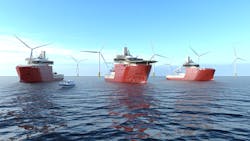Despite the COVID-19 pandemic, the world’s installed offshore wind capacity rose by 15% in 2020, reaching 31.9 GW at year-end, from 27.7 GW at the end of 2019, according to Rystad Energy.
China was the main contributor in 2020, accounting for 39% of last year’s additions, followed by the Netherlands (18%) and the UK (17%).
Rystad expects the global installed offshore wind capacity to further increase by 11.8 GW in 2021, a 37% step-up compared to 2020’s 31.9 GW. China will continue to lead the new capacity additions, contributing 63% of the expected growth.
As COVID-19 hit the Chinese market first, fears over supply chain disruptions emerged, with offshore wind developers worried about delays to projects down the line. And as the pandemic spread throughout the world, risks of a severe slump in construction activity grew. More countries closed their borders and went into lockdown and several manufacturing sites for turbines and other components temporarily shut down operations.
However, with the first wave of the virus settling, the offshore wind market returned to a growth trajectory, supported by increased capacity targets from several nations. While staying resilient in an uncertain market was key in 2020, this year the industry finds itself positioned for record growth, especially as commissioning activities pick up pace in Asia and around the world, the analyst claimed.
After 2021, China will begin phasing out feed-in-tariffs and many developers are therefore pushing to complete projects during the coming period. As such, this year is expected to see high capacity additions in the country.
Alexander Fløtre, Rystad Energy’s Product Manager for Offshore Wind, said: “China had a construction backlog of more than 10 GW going into 2020, and Chinese developers are racing to reach maximum commissioning by the end of the year in order to claim full feed-in-tariffs. This means 2021 is going to see major capacity additions, particularly since some projects initially scheduled for commissioning in 2020 ended up slipping into 2021.”
Europe and the US also saw some delays due to the pandemic. The developers of the second phase of the 50-MW Kincardine floating offshore wind project in Scotland and the Kriegers Flak combined grid solution in Denmark had to delay start-up. In October, Ørsted announced delays of at least one year for five projects due to permitting issues in the US.
Nevertheless, offshore wind developers stayed committed to their ambitions and continued to make final investment decisions for projects in 2020. The UK sanctioned more than 4.7 GW of offshore wind and the Netherlands followed with more than 2.2 GW. As a result, major projects such as Triton Knoll in the UK, Borssele 3 & 4 in the Netherlands and Kriegers Flak in Denmark are expected to be completed during 2021.
In the second half of last year, almost 25 GW of capacity was added to the global backlog, the analyst said. Currently, Brazil has no operational offshore wind capacity, but its backlog grew significantly during 2020 as the country added more than 15 GW to the drawing board.
In addition, other regions in Asia outside China are preparing for a ground-breaking year, Taiwan and Vietnam have finally started to add significant volumes to their project pipelines – making 2021 a year to look forward to in the offshore wind market, the analyst claimed.
North Star vessels to service Dogger Bank wind farm
The Dogger Bank A and B wind farm joint venture has awarded contracts totaling around £270 million ($375 million) to North Star Renewables.
North Star will provide three service operation vessels (SOVs) over a 10-year period (with extension options) for the initial two phases of the giant wind farm, 130 km (81 mi) offshore England’s northeast coast.
The vessels will be equipped with a hybrid battery solution and power-to-shore to reduce fuel consumption and emissions.
Technicians servicing the turbines will spend two weeks on board the vessels at the wind farm location to ensure the various phases are safely and efficiently maintained, allowing for optimized wind turbine availability.
SSE Renewables is the operator for the construction while Equinor will operate the operations and maintenance phase.
According to North Star, around 200 people will be required to operate the wind farm, based either offshore or at a new base at the Port of Tyne.
The company will establish a new permanent presence at the Port and will create 130 new full-time UK-based jobs in crewing and shore-based roles for the lifetime of the contract.
Dogger Bank, due to be completed in 2026, is being built in three equal phases of 1.2 GW; Dogger Bank A, B, and C.
One SOV, to be allocated for scheduled maintenance at Dogger Bank A and B, is due to be delivered in January 2024. It will also serve Dogger Bank C when this phase becomes operational.
A further two SOVs for corrective maintenance purposes will be delivered at Dogger Bank A and Dogger Bank B, with delivery scheduled for July 2023 and July 2024, respectively.
Equinor added that a further contract for an SOV to provide corrective maintenance at Dogger Bank C will be tendered at a later stage.
Each vessel will have DP-2 capability, with walk-to-work gangways for transfer of personnel and equipment to and from the turbines.
Using the gangways, technicians will be able to transfer safely in wave heights above 3 m (9.8 ft), increasing the productive time on turbines and optimizing the wind turbines’ availability.
Onshore construction for Dogger Bank A and B started in January 2020. Offshore installation is due to begin in 2022, with first power from Dogger Bank A anticipated later in the same year.
Dogger Bank A and B are a joint venture between Equinor (40%), SSE Renewables (40%), and Eni (20%). Dogger Bank C is owned by Equinor (50%) and SSE Renewables (50%): financial close is anticipated in late 2021.




